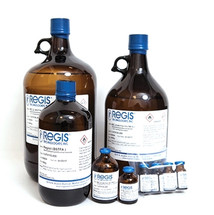Posted by Chrom Tech on 15th Oct 2025
Why Use GC Derivatization Reagents
Gas Chromatography (GC) is used to separate and analyze volatile organic compounds. However, many compounds of analytical interest are not inherently volatile or thermally stable enough for GC analysis. Derivatization reagents modify the functional groups of these analytes, improving their chromatographic behavior and detection sensitivity. When properly applied, GC derivatization can enhance both performance and accuracy of your analytical methods.
Why Use Derivatization in Gas Chromatography?
The key benefits of derivatizing reagents include:
- Increased volatility – improves analyte transfer through the GC column
- Enhanced selectivity and resolution – aids in separating structurally similar compounds
- Improved detectability – increases signal response for trace components
By chemically modifying analytes, derivatization ensures reproducible, sharp peaks and robust analytical data across various GC detection systems.
Selecting the Right Derivatization Reagent
An ideal derivatization reagent should be reproducible, efficient, and nonhazardous. When choosing one for GC analysis, keep these criteria in mind:
- Reacts completely (95–100%) with the target compound
- Does not alter or rearrange the analyte structure
- Minimizes sample loss during the reaction
- Forms stable derivatives that do not react with the GC column
- Provides consistent results over time
Chrom Tech proudly distributes Regis GC Derivatization Reagents. For over 60 years, Regis Technologies has manufactured high-purity reagents under strict quality control. GC derivatization typically involves one of three main reaction types: silylation, acylation, or alkylation.
Silylation Reagents
Silylation is the most widely used GC derivatization technique. It replaces active hydrogens in functional groups (–OH, –NH, –SH, –COOH) with a silyl group such as trimethylsilyl (TMS) or t-butyldimethylsilyl (t-BDMS). These reactions yield derivatives that are more volatile, less polar, and more thermally stable than their parent compounds.
Because silylation reagents are moisture-sensitive, they should be kept sealed to prevent hydrolysis. TMS derivatives are particularly sensitive, whereas t-BDMS derivatives are up to 10,000 times more hydrolysis-resistant. Both reagent types are suitable for a broad range of compounds and compatible with GC/MS analysis. For GC/MS-specific applications, MtBSTFA is often preferred for producing stable, efficient derivatives.
Acylation Reagents
Acylation reagents offer similar benefits to silylation reagents but are especially useful for highly polar compounds such as amino acids and carbohydrates. These reagents create less polar, more volatile derivatives and can introduce electron-capturing groups that enhance detection sensitivity, particularly when using Electron Capture Detection (ECD).
Common acylating agents include acid anhydrides, acyl halides, and acyl derivatives. Fluorinated anhydrides, in particular, improve ECD and Flame Ionization Detection (FID) response. Because of their acidic nature, excess reagent or byproducts should always be removed prior to analysis to protect column integrity.
Alkylation Reagents
Alkylation reagents modify active hydrogens (such as those in carboxylic acids or phenols) by substituting them with an alkyl group, reducing molecular polarity. They can be used alone or alongside acylation or silylation reagents for more complex derivatization strategies—especially useful for multifunctional compounds like amino acids.
The most common alkylation reaction, esterification, combines an acid and alcohol in the presence of a catalyst to form stable alkyl esters. Adjusting the length of the alkyl group can tailor compound retention. Alkylation is also beneficial in biological extractions, improving recovery from complex matrices.
Chiral Derivatization Reagents
For chiral GC analysis on achiral columns, enantiopure derivatization reagents are used to form diastereomeric derivatives of enantiomers. The resulting chromatographic separation allows determination of enantiomeric ratios and concentrations—an essential step in pharmaceutical and biochemical research.
Choosing the Right Vials for GC Derivatization
Reaction vials must withstand temperature extremes and chemical exposure during derivatization. Chrom Tech recommends NextGen™ V-Vials® from DWK, available in 0.1–10 mL capacities, ideal for micro-scale derivatization reactions. These screw-cap vials are durable and designed for autosamplers.
Deactivation of Glassware
Glassware surfaces are slightly acidic and can adsorb analytes—especially amines—leading to sample loss during trace analyses. To prevent this, glassware is often silanized, coating Si–OH groups with a non-adsorptive silicone layer to render the surface inert.
RSA™ Low Adsorption Vials
RSA™ Vials from Chrom Tech offer a modern alternative to silanization. Made through a proprietary process that eliminates surface silanol groups, RSA™ Vials feature inherently inert glass surfaces without coatings—ideal for sensitive GC derivatization reactions.
Conclusion
Using derivatization reagents in gas chromatography is often essential to achieve reproducible, high-resolution separations. Skipping this step can result in incomplete analysis, loss of sensitivity, and poor reproducibility. Selecting the right reagent—whether silylation, acylation, or alkylation—depends on the compound’s chemistry and detection method. Equally important is choosing appropriate, low-adsorption glassware for reliable results.
Chrom Tech offers a full range of GC derivatization reagents, vials, and accessories to optimize your analytical workflow. Contact our technical support team today for expert guidance on selecting the ideal reagents for your application.
Frequently Asked Questions About GC Derivatization Reagents
Why is derivatization necessary in gas chromatography?
Derivatization improves analyte volatility, thermal stability, and detectability—making compounds suitable for GC analysis that otherwise might decompose or elute poorly.
What are the main types of GC derivatization reactions?
The three primary types are silylation, acylation, and alkylation. Each targets different functional groups and offers distinct advantages for various compound classes.
What is the benefit of using RSA™ or silanized vials in GC derivatization?
RSA™ and silanized vials minimize analyte adsorption by reducing active silanol sites on glass surfaces, improving recovery and consistency in trace-level GC analyses.

